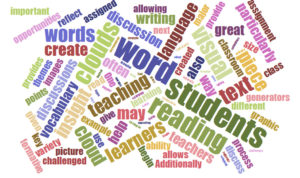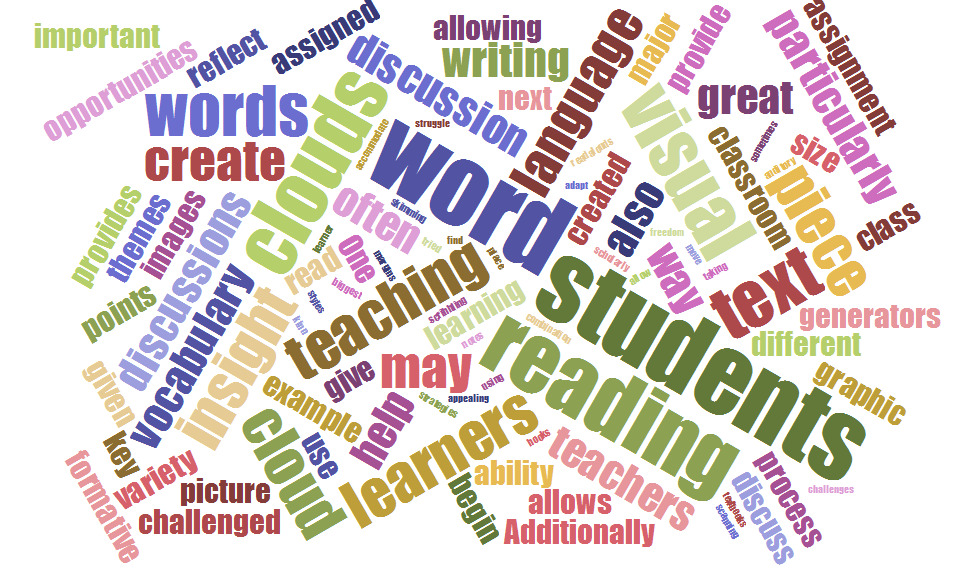

One of the biggest challenges of teaching is appealing to all the different learning styles in a classroom. Teachers have tried to adapt to each kind of learner using a combination of teaching strategies. For example, we give students the freedom to find their own place to read or accommodate auditory learners by doing read-alouds in the classroom.
Visual learners can get overwhelmed by large amounts of text
Visual learners struggle as textbooks move from picture books to more scholarly reading, sometimes scribbling or taking notes in the margins. While some visual learners are great at skimming and scanning, decoding large amounts of text can be overwhelming for others. One great way to help all students — particularly visual learners — engage with reading in a new way is to use word clouds.
Word clouds give students a new way to see texts
A word cloud is a picture made from a piece of text. They can be simple or complex, but are generally created from an algorithm that removes common language and then measures word frequency and represents word size based on the number of appearances in the text.
A variety of word cloud generators are available online or through apps, and many of them are free. The generators often give teachers or students the ability to input cut and pasted text, then manipulate the images it creates via color, font, and overall effect. By giving students a different view of their reading, word clouds can provide deep insight into their interaction with a text.
Students can use word clouds to find unfamiliar language
For example, word clouds make great visuals for an anticipatory set. On the Teaching Channel, middle school science teacher Daniel Hill explains how he uses word clouds to create opportunities for exploring the theme and content of a piece of assigned reading. He also encourages his students to spy words or language that might be unfamiliar.
Because word clouds arrange language by size, the words that reflect themes of a piece of reading are often the largest words in the image. They also force decontextualization, which can bring student’s attention to specific unknown vocabulary words they may have skipped over in their own reading. If students anticipate difficulty with a word, they can look it up or discuss it before they even begin the assignment.
Giving students a visual can spark insightful discussion of what they’ve read
Projecting a word cloud during a course discussion also gives students a visual to reflect on during discussions of the material. Because theme-reflecting language often appears as larger text or may appear as a variety of slightly smaller synonyms, students see a visual representation of the main points in their reading. This provides insight and opportunities for discussion, particularly if students had a difficult time understanding a piece or felt that key themes were not adequately visualized in the graphic.
Additionally, students who may have missed a major aspect of the reading are given insight with a graphic representation. If class discussions falter or veer off from major points, the projected visual provides opportunity to pull students back to appropriate discussion.
Student-created word clouds serve as a powerful formative assessment tool
As an assignment, students can be challenged to create their own word clouds. Some of the creation software allows students to weight the importance of vocabulary words, though this effort can be recreated by simply typing the word into a general text box multiple times. To help students measure their own comprehension of an article, they can be challenged to create a vocabulary list of important words or key phrases from a reading and then assigned to create a word cloud that accurately conveys the given vocabulary’s importance.
Student-created word clouds can then be compared and contrasted or displayed next to a cloud created from the actual writing, allowing for a quick visual of a student’s comprehension as well as any gaps or misunderstandings they may have about the reading they have done. This makes for swift but important formative assessment and allows for immediate feedback for students to incorporate into their learning.
Word clouds are a teaching strategy for different learning styles
Word clouds give unique insight into reading assignments and help visual learners process reading assignments in a way they aren’t necessarily accustomed to seeing them. Additionally, such images facilitate class discussions and formative assessments, allowing teachers some deeper insight into student understanding.
Furthermore, word clouds can and do provide far more advantages, particularly when students begin to read for style or learn their own writing process. In my next piece, I will discuss the importance for using word clouds to teach writing.
Monica Fuglei is a graduate of the University of Nebraska in Omaha and a current faculty member of Arapahoe Community College in Colorado, where she teaches composition and creative writing.
Categorized as: Tips for Teachers and Classroom Resources
Tagged as: Engaging Activities, Language Arts
